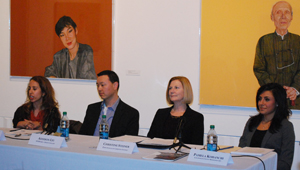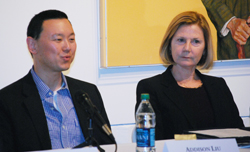-Story and Photos by Maria Iacobo
On a day when the art world made headline news – Los Angeles’ Getty Museum of Art unveiled a J.M.W. Turner painting it acquired for $45 million – USC Law’s Art Law Society held a panel discussion on the business forecast of art and the roles attorneys play in the art world. 
The nascent organization delivered a stellar lineup for an audience of law students and USC Law alumni set in one of USC’s Fisher Museum galleries. Jessica Kantor, an associate in the Art Law Practice Group in Sheppard, Mullin, Richter & Hampton, served as the panel’s moderator. Offering a glimpse of their day-to-day activities, the three panelists illustrated the range of roles an attorney, gallery owner and museum general counsel play to an audience of 60.
“Art is cyclical to some extent,” said Christine Steiner, an attorney with a private practice in art law. “There are legal issues in the life cycle of any art collection, beginning with its acquisition.”
The final activity with any piece of art is its sale, which according to Steiner is a result of the “three Ds: death, divorce or debt.” With its sale, the cycle will recommence.
Steiner has extensive experience in art law, intellectual property and has taught art law at Loyola Law School for the past 13 years.
For panelist Addison Liu, a typical day is that of any small business. Described by Kantor as a contemporary “Renaissance Man, ” Addison Liu represents a variety of artists in a Los Angeles gallery, HVW8 Art + Design, he co-founded, advises clients in the music business and is a documentary film producer. Day-to-day issues include determining a calendar of future exhibits, obtaining insurance for events and exhibits and space planning.
“A rotating broad base of work” is how Pamela Kohanchi, associate general counsel for the Los Angeles County Museum of Art (LACMA), described the many areas of law she encounters on the job.
 “I operate almost as a general practitioner,” said Kohanchi. “I deal with a variety of issues in employment law, intellectual property, licensing, acquisitions and insurance. The most exciting part is that I’m never bored.”
“I operate almost as a general practitioner,” said Kohanchi. “I deal with a variety of issues in employment law, intellectual property, licensing, acquisitions and insurance. The most exciting part is that I’m never bored.”
In examining how digitization and new media are impacting the art world, Kohanchi said social media has “exploded” at LACMA and the museum continues to embrace it. LACMA has 145,000 followers on its Twitter feed and is one of the few art institutions to have a Spanish-language Twitter feed.
“We’ve developed a mobile app that tours specific rotating works at the museum,” said Kohanchi. “The app changes daily to encompass the different daily events as well.”
“Compensation. Copyright. Control. I worry about these three things,” regardless of the medium, she explained.
As for a career in art law, the attorneys shared the same advice: you need to be a good lawyer first and foremost; you don’t need to know a lot about art.
“Art law is a misnomer,” said Steiner. “It’s torts. It’s criminal law. It’s copyright law. You have to love it and do your homework. It’s the same advice I give my clients when they are considering a piece of art to purchase.”
Kohanchi agreed and urged law students to become good lawyers so that when the opportunity becomes available they will have a variety of skills to draw upon.
Her advice mirrored Kantor’s career path. Though she had an extensive background in the arts before admission to the bar, Kantor began her legal career as a transactional attorney at a small entertainment law firm.
“Starting in a firm is a good start,” she confirmed.
About the Art Law Society
A great cinema school. Noted art and theater schools. A respected art museum. These institutions all reside on the USC campus.
Arising from a strong interest in the arts and in pursuing a career in law that will allow them to connect with the many forms art embraces, USC Law students founded a new student organization during the 2008-09 class year. Now in its second year, the Art Law Society already has a strong following with 90 members.
“USC Law has a strong entertainment law organization, but we felt it was important to have a separate organization that deals with art and issues specific to art work such as cultural property, artists’ rights, and buying and selling art,” said Kim Church ’12, president of the organization. “The Art Law Society provides another forum for students to learn about these different issues.”
USC Law’s emphasis on interdisciplinary studies was one of the reasons Church chose to attend USC. Church says she has benefited from the society.
“I studied art history in college and always had an interest in the arts so I really wanted to maintain a connection to the arts with my legal studies,” said Church. “I’m definitely contemplating a career in law that involves art. It’s still too early to tell, but it’s been great for me to explore those options as a student.”.jpg)
Other students concur.
The society brings attorneys who practice in different areas of law, but whose work is immersed in the art world, to the law school to speak with students.
“When I started law school, I quickly became discouraged that finding a job as a lawyer in the art world would be as difficult as being an artist,” said Mary Ramsey ’12, the society’s External Vice President. “It’s a real niche area of law. But, all the lawyers who have come to speak with us have been friendly and encouraging.”
Ramsey has contacted nearly two dozen attorneys working in the art world and been granted informational interviews, which she has found helpful.
The Art Law Society also provides opportunities for students to share experiences at a variety of events in the art world. Church says one of her favorites has been the monthly Downtown L.A. Artwalk.
“It’s connected me with 1Ls and 3Ls as well as others in my class,” says Church. “Otherwise we might not have crossed paths. We browse the galleries and get food from the food trucks. It’s a lot of fun. You can see some strange things. It’s nice to explore and see what’s up.”
Before the recent event at Fischer Gallery, Ramsey was unaware the USC campus housed an impressive art museum, but a field trip organized by the society introduced her to it – and the impressive photography exhibit of famed portraitist Yousuf Karsh.
“I walked in and thought it was a great exhibit, said Ramsey. “It struck me that I really did want to find a way to practice law in the arts and that I had to make something happen for myself,” said Ramsay. “I credit the art law society for helping me decide what to do.”
-- Maria Iacobo

















